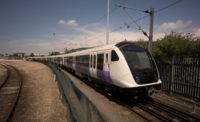From the roof of Sweco headquarters in Stockholm’s downtown Kungsholmen district, cranes from one of the city’s largest infrastructure projects are visible a few kilometers away across Lake Mälaren.
Sharing space with throngs of tourists is the estimated $1.4-billion Slussen megaproject to improve north-south transportation and replace the old sluice and lock separating the freshwater lake from the salty Baltic Sea.
The company location is convenient, with its key roles on the project that began in 2016 and is set for completion in 2025.
The core of the estimated $1.4-billion Slussen project is the removal of two 1930s-era deteriorating concrete bridges between two downtown islands. Between these bridges, the lock and sluice is being replaced by a system with about five times greater drainage capacity to ease lake flood risk.
Under a master plan for the city by U.K.-based Foster + Partners with Berg Arkitektkontor, the area around the lock will be developed into a new district with public spaces, pedestrian and cycle routes and major buildings. One old bridge has already been torn down, and demolition is underway on a crumbling concrete highway cloverleaf junction.
Skanska AB aims to complete by 2022 the new lock and a 140-m-long steelwork bridge under two city contracts worth $220 million.
Sweco had contracts to study new Slussen water, sewerage, energy and ventilation systems as early as 2009, and later it undertook conceptual designs of electrical and mechanical systems in the planning phase. Underpinning the whole project is “Slussnet,” developed by Sweco and said to be one of Sweden’s first totally digital systems—a tough sell at first to project managers but now with about 1,000 users. “We don’t use any drawings, only [digital] models,” says David Möller, a Sweco engineer acting as the owner’s virtual design and construction manager.
Nearby, the $350-million upgrade of Getingmidjan, the 1950s-era rail transportation system, by Swedish national agency Trafikverket, will include 2 km of city track, as well as bridge and tunnel renovation and replacement. In an eight-week system closure that began in June and will be repeated over the next two summers, contractor Implenia Sverige A.B. has begun work that is set to finish in 2021. Dealing with disparate aging structures, “the main problem is knowledge of existing conditions,” says Per Ekström, a Sweco rail design manager.
Under a contract worth about $12.6 million in fees, Sweco handled project conceptual design and is supporting Trafikverket during construction. A Sweco team also is preparing bid documents due out later this year and is handling design and site supervision for a larger Trafikverket central station rail and platform upgrade, says Emma Rudh, Sweco assistant project manager. With 1,000 daily train movements in the station, ”our main challenge is to keep traffic going,” she adds.
Related Article: Sweco's Future Takes Shape Under New CEO Asa Bergman




